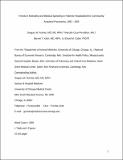| dc.contributor.author | Ruhnke, Gregory W. | |
| dc.contributor.author | Coca-Perraillon, Marcelo | |
| dc.contributor.author | Kitch, Barrett Tyler | |
| dc.contributor.author | Cutler, David M. | |
| dc.date.accessioned | 2011-11-14T15:53:52Z | |
| dc.date.issued | 2010 | |
| dc.identifier.citation | Ruhnke, Gregory W., Marcelo Coca-Perraillon, Barrett T. Kitch, and David M. Cutler. 2010. Trends in mortality and medical spending in patients hospitalized for community-acquired pneumionia: 1993-2005. Medical Care 48(12): 1111-1116. | en_US |
| dc.identifier.issn | 0025-7079 | en_US |
| dc.identifier.uri | http://nrs.harvard.edu/urn-3:HUL.InstRepos:5344530 | |
| dc.description.abstract | Background: Community-acquired pneumonia (CAP) is the most common infectious cause of death in the United States. To understand the impact of efforts to improve quality and efficiency of care in CAP, we examined trends in mortality and costs among hospitalized CAP patients. Methods: Using the National Inpatient Sample from 1993–2005, we studied 569,524 CAP admissions. The primary outcome was mortality at discharge. We used logistic regression to evaluate the mortality trend, adjusting for age, gender, and comorbidities. To account for the impact of early discharge practices, we also compared daily mortality rates and performed a Cox proportional-hazards model. We used a generalized linear model to analyze trends in hospitalization costs, which were derived using cost-to-charge ratios. Results: Over time, length of stay (LOS) declined, while more patients were discharged to other facilities. The frequency of many comorbidities increased. Age/gender-adjusted mortality decreased from 8.9% to 4.1% (P < 0.001). In multivariable analysis, the mortality risk declined through 2005 (odds ratio, 0.50; 95% confidence interval [CI], 0.48–0.53), compared to reference year 1993. The daily mortality rates demonstrated that most of the mortality reduction occurred early during hospitalization. After adjusting for early discharge practices, the risk of mortality still declined through 2005 (hazard ratio, 0.74, 95% CI 0.70–0.78). Median hospitalization costs exhibited a modest reduction over time, mostly due to reduced LOS. Conclusions: Mortality among patients hospitalized for CAP has declined. Lower in-hospital mortality at a reduced cost suggests that pneumonia is a case of improved productivity in health care. | en_US |
| dc.description.sponsorship | Economics | en_US |
| dc.language.iso | en_US | en_US |
| dc.publisher | American Public Health Association | en_US |
| dc.relation.isversionof | doi:10.1097/MLR.0b013e3181f38006 | en_US |
| dc.relation.hasversion | http://www.ncbi.nlm.nih.gov/pubmed/21063230 | en_US |
| dash.license | OAP | |
| dc.title | Trends in Mortality and Medical Spending in Patients Hospitalized for Community-Acquired Pneumonia: 1993–2005 | en_US |
| dc.type | Journal Article | en_US |
| dc.description.version | Accepted Manuscript | en_US |
| dc.relation.journal | Medical Care | en_US |
| dash.depositing.author | Cutler, David M. | |
| dc.date.available | 2011-11-14T15:53:52Z | |
| dc.identifier.doi | 10.1097/MLR.0b013e3181f38006 | * |
| dash.contributor.affiliated | Kitch, Barrett | |
| dash.contributor.affiliated | Cutler, David | |


